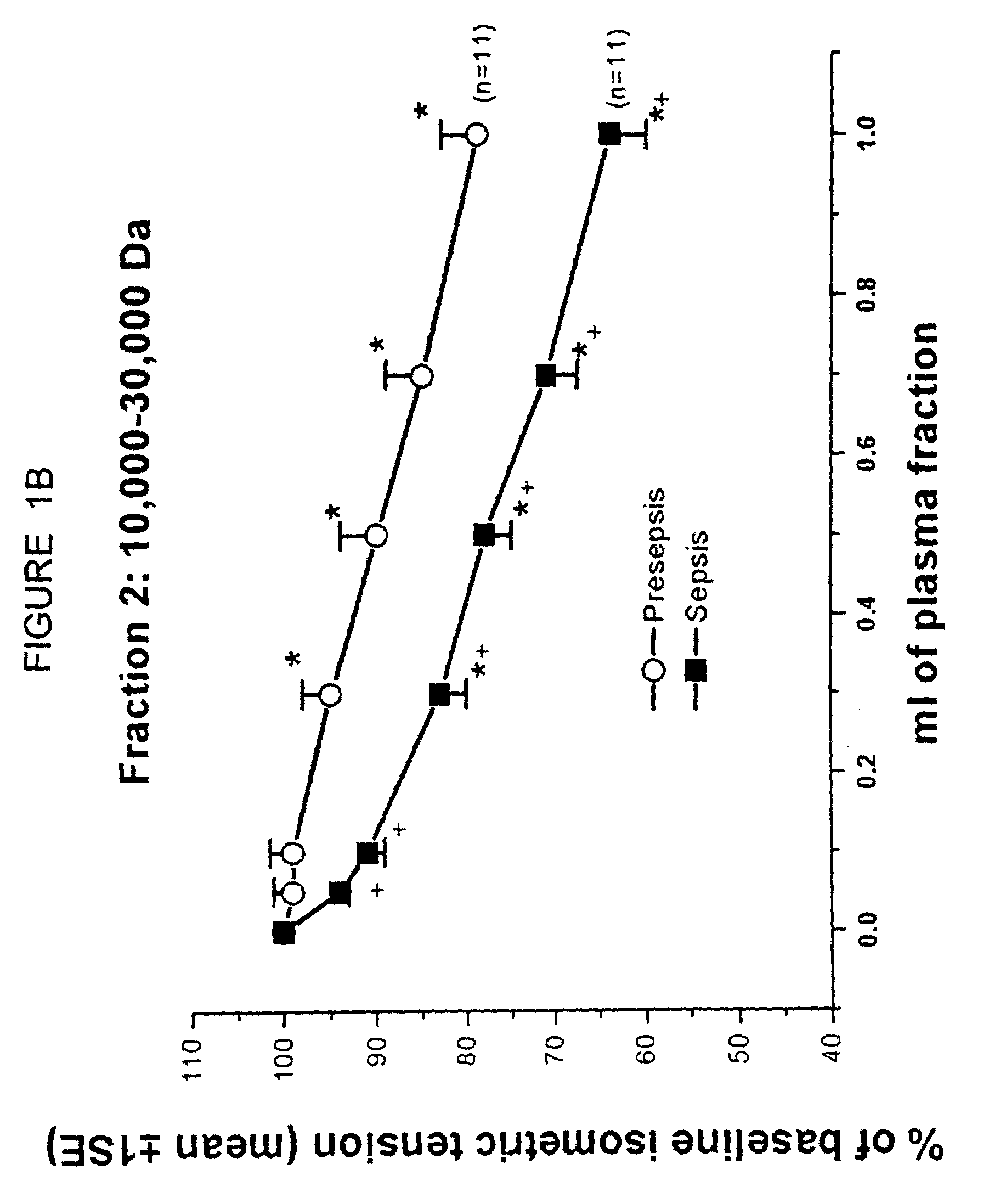Methods of treating inflammation
a technology of inflammation and treatment method, applied in the field of inflammation treatment method, can solve the problems of septic shock, 50% mortality rate associated with septic shock has improved little, and the death rate of approximately 30%, so as to reduce the extent of myocardial depression, prevent isometric tension depression, and increase the potential to cause myocardial depression
- Summary
- Abstract
- Description
- Claims
- Application Information
AI Technical Summary
Benefits of technology
Problems solved by technology
Method used
Image
Examples
example 1
Lysozyme: a Mediator of Myocardial Depression and Adrenergic Dysfunction in Septic Shock
[0112]The objective of the present study was to identify the nature of a filterable cardiodepressant factor (FCS) that contributes to myocardial dysfunction in a canine model of Escherichia coli septic shock. In a previous study, it was found that FCS increased in plasma after 4 h of bacteremia (Am J Physiol 1993; 264: H1402) in which FCS was identified by a bioassay that included a right ventricular trabecular preparation (RVT). In that study, FCS was only partially identified by pore filtration techniques and was found to be a protein of molecular weight between 10-30K. In the present study, FCS was further purified by size exclusion high pressure liquid chromatography, until a single band was identified on one dimensional gel electrophoresis. This band was then subjected to tandem mass spectrometry and protein sequencing techniques and both techniques identified FCS as lysozyme c (Lzm-S), cons...
example 2
N,N′,N″ Triacetylglucosamine, an Inhibitor of Lysozyme, Prevents Myocardial Depression in E. coli Sepsis in Dogs
Objection
[0146]The inventors previously found that lysozyme c (Lzm-S), consistent with that originating from the spleen, was a mediator of myocardial depression in an Escherichia coli model of septic shock in dogs (Example 1). The inventors further showed in a right ventricular trabecular preparation (RVT) that Lzm-S's depressant activity could be blocked by N,N′,N″ triacetylglucosamine (chitotriose or TAC), a competitive inhibitor of Lzm-S. The inventors hypothesized that Lzm-S binds to or cleaves a cardiac membrane glycoprotein thereby interfering with myocardial contraction in sepsis. In the present study, the inventors examined whether TAC could prevent myocardial depression in an in vivo preparation and whether other related NAG structures could also inhibit Lzm-S's effect in RVT.
[0147]In one part of the present study, the effect of TAC on myocardial function when tre...
example 3
Specific Lectins Mimic the Myocardial Dysfunction Caused by Lysozyme in Canin v Ntricl
[0185]In the present Example, the inventors hypothesized that lectins with a carbohydrate specificity similar to that described for lysozyme with primary affinity for oligomers of N-acetylglucosamine (NAG-NAG-NAG structure) (eg Datura stramonium lectin and Lycopersicon esculentum lectin) would cause myocardial depression in a right ventricular trabecular preparation (RVT). The inventors compared the latter lectins with those with affinities to variants to the NAG-NAG-NAG structure, that included affinities for the chitobiose structure (NAG-NAG: Triticum vulgaris lectin), for the N-acetyllactosamine structure (Erythrina corallodendron lectin), and for terminal N-acetyl galactosaminyl residues (Helix pomatia lectin). The results showed that lectins with an affinity for the NAG-NAG-NAG structure demonstrated a depression in isometric tensions similar to that described for lysozyme which was significan...
PUM
| Property | Measurement | Unit |
|---|---|---|
| diameter | aaaaa | aaaaa |
| flow rate | aaaaa | aaaaa |
| pH | aaaaa | aaaaa |
Abstract
Description
Claims
Application Information
 Login to View More
Login to View More - R&D
- Intellectual Property
- Life Sciences
- Materials
- Tech Scout
- Unparalleled Data Quality
- Higher Quality Content
- 60% Fewer Hallucinations
Browse by: Latest US Patents, China's latest patents, Technical Efficacy Thesaurus, Application Domain, Technology Topic, Popular Technical Reports.
© 2025 PatSnap. All rights reserved.Legal|Privacy policy|Modern Slavery Act Transparency Statement|Sitemap|About US| Contact US: help@patsnap.com



